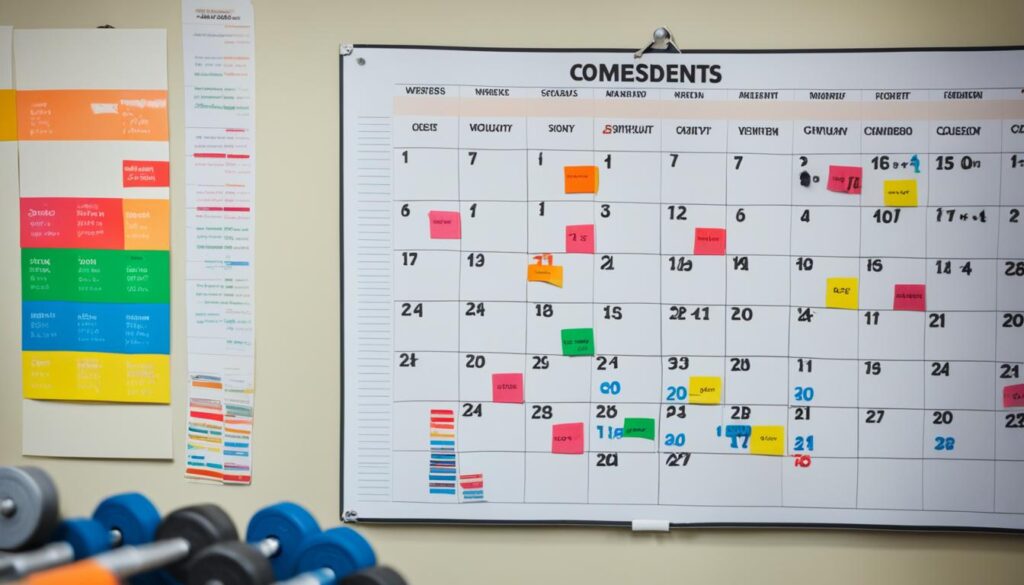Embarking on a fitness journey after a prolonged hiatus can feel daunting, but it’s never too late to reclaim your health and wellness. This comprehensive guide will provide you with a safe and effective workout plan to ease back into exercise, set realistic goals, and regain your fitness level step by step. The key is to start small, mix cardio and strength training, prioritize recovery, and celebrate your progress along the way.
Building a habit takes about six weeks of regular practice, as indicated by experts1. Consistency in gym visits or workouts is crucial for habit formation1. By committing to just 10 minutes a day for exercise, you can create a manageable and motivating starting point for your fitness restart2. Setting specific, realistic, and achievable goals, like working out for 20 minutes for 3 days a week, can help you stay motivated and maintain a routine2.
Regular exercise can lead to the formation of new healthy habits, eventually integrating the workout routine into daily life2. Consistency in daily exercise routines helps establish these habits over time3. Taking on a one-month fitness challenge can kick-start your workout routine, while two-week challenges can be effective for those finding it daunting to commit to a longer period3.
Key Takeaways
- Start small with manageable daily exercise commitments
- Set realistic, achievable fitness goals to stay motivated
- Consistency is key to building sustainable workout habits
- Consider short-term fitness challenges to kickstart your routine
- Seek support from workout partners or groups to stay accountable
Start Small with Low-Intensity Workouts
When restarting your fitness journey after a long break, it’s crucial to take a gradual approach. Begin by incorporating just 10 minutes of low-intensity exercise per day4 and slowly increase the duration and intensity as you rebuild your endurance and strength4. This measured approach will help you avoid burnout and prevent injury, setting you up for sustainable progress.
Take it Slow and Rebuild Gradually
The key is to start with two workout days per week4 and gradually increase to three times a week4 as your body adapts. Rushing into a high-frequency routine can lead to discouragement and burnout, so it’s best to set realistic goals4 and celebrate small wins along the way4. Regular exercise has been shown to improve health significantly, reduce the risk of chronic diseases, and manage weight5 – making it a worthwhile investment in your well-being.
Focus on Form and Consistency
As you rebuild your fitness, it’s essential to maintain proper exercise form4 to prevent injury and maximize the benefits of your workouts4. Additionally, making exercise a consistent habit5 is crucial for long-term success5. A few weeks of inactivity can lead to significant losses in muscle strength, neurological awareness, and joint flexibility6, so staying committed to a regular, consistent workout routine6 is key.
Remember, the journey to fitness is not a sprint, but a marathon. By starting small with low-intensity workouts6 and gradually increasing the intensity and frequency, you’ll rebuild your fitness in a sustainable way4 and set yourself up for long-term success456.
Mix Cardio and Strength Training
Achieving a balanced workout routine is crucial for improving overall fitness and well-being. By incorporating a combination of cardio and strength training exercises, you can target all major muscle groups, boost your metabolism, and enhance your cardiovascular health7.
Cardio exercises like walking, jogging, or cycling can help you burn calories and improve your endurance7. The American College of Sports Medicine and the Centers for Disease Control and Prevention recommend that adults aim for at least 150 minutes of moderate-intensity cardiovascular exercise per week for optimal health benefits7. If you engage in vigorous cardio, where breathing becomes too challenging to speak, you can cut the recommended time in half7.
Complementing your cardio routine with strength training exercises is essential for building and maintaining muscle mass. Resistance training, such as weightlifting or bodyweight movements, can help you tone your muscles, improve your metabolic rate, and enhance your overall fitness8.
Incorporating both low-rep, high-weight training, and high-rep, low-weight training into your routine can be beneficial for muscle strength and endurance8. The CDC recommends engaging in strength training activities at least 2 days per week for optimal health and weight management8.
High-Intensity Interval Training (HIIT) is a time-efficient and effective way to combine cardio and strength training. HIIT workouts can lead to excess post-exercise oxygen consumption, resulting in higher caloric expenditure even after the workout8.
Remember, the key is to find a balanced workout routine that works for you. Experiment with different exercises and intensities to discover what you enjoy and what helps you achieve your fitness goals9.
By incorporating both cardio and strength training into your fitness regimen, you can improve your overall health, boost your metabolism, and work towards a more balanced workout routine789.
Stretch and Recover Properly
Restarting your fitness routine after a prolonged break requires a thoughtful approach to stretching and recovery. Proper stretching and mobility exercises not only improve your range of motion but also help prevent injuries as you rebuild your strength and endurance.10 Additionally, effective post-workout recovery strategies are crucial for allowing your muscles to repair and rebuild, ensuring a smooth transition back into your fitness journey.
Importance of Stretching and Mobility
Incorporating dynamic and static stretches into your workout routine is essential for increasing flexibility and improving overall mobility10. Improved mobility can enhance the effectiveness of your exercises, reducing the risk of strains or other injuries as you push your body to regain fitness levels10. Dedicating time to mobility work can also help you maintain proper form and technique, further minimizing the potential for setbacks.
Post-Workout Recovery Strategies
Effective post-workout recovery strategies play a vital role in your fitness restart. Techniques like foam rolling, ice baths, and proper nutrition can aid in muscle repair and reduce recovery time between workouts10. Allowing your muscles to rest and recover properly is crucial to avoid overuse injuries and ensure a sustainable fitness journey11.
By prioritizing stretching, mobility, and post-workout recovery, you can improve your mobility, support muscle recovery, and prevent injuries as you rebuild your fitness.12 Incorporating these elements into your routine will help you restart your fitness journey safely and effectively.
| Stretching Exercises | Benefits |
|---|---|
| Hamstring Stretch | Increases flexibility, improves range of motion |
| Shoulder Rolls | Improves shoulder mobility, reduces risk of injury |
| Calf Raises | Strengthens and stretches calf muscles |
| Hip Flexor Stretch | Reduces tightness, enhances lower body mobility |
“Consistency is key when it comes to stretching and mobility work. Make it a habit, and you’ll see the long-term benefits in your fitness journey.”
Set Realistic and Achievable Goals
When restarting your fitness journey, it’s crucial to set realistic and achievable goals. Start small with short-term objectives, such as working out 2-3 times per week13, and then gradually work towards longer-term goals like improving your running time or lifting heavier weights13. Celebrating these small wins along the way will keep you motivated and on track.
Short-Term and Long-Term Goal Setting
To create a successful fitness plan, incorporate the SMART framework: Specific, Measurable, Achievable, Relevant, and Time-bound13. Start with short-term goals, such as incorporating three cardio and two strength training sessions per week, performing stretching or yoga twice a week, and working up to a 5K run over three months13. As you progress, adjust your goals to increase the challenge and keep pushing yourself.
Remember to tailor your goals to your current fitness level and desired outcomes. Focus on building a solid foundation through strength training exercises that target major muscle groups using dumbbells and bodyweight movements like squats, push-ups, and lunges13. Complement this with a mix of aerobic activities and interval training, such as jogging, swimming, cycling, and high-intensity bursts, to improve your cardiovascular health13.
It’s essential to listen to your body and recognize signals of fatigue, discomfort, and pain to prevent injuries and ensure continuous growth in your fitness journey13. Adjust your goals as needed, and celebrate your progress along the way to stay motivated and engaged.
By setting realistic and achievable goals, you can create a comprehensive fitness plan that not only helps you regain your physical prowess but also keeps you motivated and engaged in the long run13. Remember, the key is to start small, be patient, and celebrate your successes along the way131415.
Make It Social and Enjoyable
Incorporating social and enjoyable elements into your workout routine can be a game-changer in helping you stay consistent and motivated. Consider working out with a friend or joining a fitness class to find the camaraderie and support that can make exercise feel less like a chore and more like a fun social activity16. Health professionals advise working towards 150 minutes of exercise per week as recommended by the Department of Health and Human Services16.
Finding an activity you genuinely enjoy, such as dancing, hiking, or even a sport, can make it easier to stick to your fitness routine. When you find joy in the process, you’re more likely to prioritize it and make it a consistent part of your lifestyle16. Experts recommend focusing on making one change at a time to re-establish an activity habit rather than trying to overhaul both exercise and diet habits simultaneously16.
- Workout with a friend or join a fitness class to make exercise a social experience.
- Discover activities you genuinely enjoy, such as dancing, hiking, or sports.
- Incorporate physical activity into your daily routine, like taking the stairs or going for family walks.
Making fitness a fun and social experience will help you stay motivated and on track with your goals17. Exercising with a buddy or a group is noted to enhance motivation, even if done virtually or through text support to maintain social distancing18.
“It’s not about the destination, it’s about the journey. Enjoy the process, not just the end result.” – Anonymous
Remember, the key to long-term fitness success is finding an approach that you can truly stick to and enjoy. So, get creative, have fun, and embrace the social aspect of your fitness journey18. It is highlighted that it is never too late to start exercising, emphasizing that the results of exercise are cumulative, and everyone can find suitable exercises regardless of age, fitness level, or space availability18.
Schedule and Prioritize Your Workouts
To ensure you follow through with your fitness plan, it’s crucial to schedule and prioritize your workouts. Block off time in your calendar for exercise, just as you would for any other important commitment. Treat your workout sessions as non-negotiable appointments to help make fitness a consistent part of your lifestyle19.
Consistency is the key to overcoming setbacks and rebuilding your strength after a long break20. Once you’ve set aside dedicated workout time, stick to your schedule as much as possible. Missing 1-2 sessions generally does not significantly impact progress if training has been consistent up to that point20.
If you do miss a session or two, don’t be too hard on yourself. For novice or early intermediate lifters, missing 1-2 weeks might require reducing weights by around 10% for squat and deadlift, and 5-15 lbs for press and bench press20. After missing two or more weeks, it is advised to work up to a moderately hard set for squats, bench press, and deadlifts before progressing to regular sets20.
As you prioritize your workouts, consider factors such as your training level, body weight changes, and recovery factors. Beginners may regress quicker with missed training and require slight weight resets, progressing back to previous records in small increments20. Advanced lifters may need more substantial weight resets but can make faster gains by taking larger jumps each session20.
Remember, the reason for missing training (e.g., illness, vacation, stressful event) should also be taken into account when determining how to resume your workouts20. By prioritizing your fitness and creating a consistent schedule, you’ll be well on your way to rebuilding your strength and endurance after a long break19.

“Consistency is the key to overcoming setbacks and building back strength.”
Use Fitness Trackers and Apps
When restarting your workout routine, fitness trackers and mobile apps can be invaluable tools. These technologies can help you monitor your progress, set achievable goals, and stay motivated throughout your fitness journey21. Some of the most popular fitness tracking apps and devices include Fitbit, Apple Watch, MyFitnessPal, and Strava, each offering unique features and capabilities tailored to different fitness needs and preferences.
Popular Fitness Tracking Apps and Devices
Fitness trackers and apps offer a range of functionalities to enhance your workout experience. Over 75% of individuals prefer using these tools to track their workouts and progress21. Many users find it important that a workout tracker is quick and easy to use, saving time during exercise sessions21. Additionally, approximately 45% of individuals prefer workout trackers that provide essential information to track progress and reduce errors during workouts21.
When selecting a fitness tracking app or device, versatility is often a key consideration. Over 50% of users look for workout trackers that can adapt to different workout styles and training routines21. For example, the Jefit app is identified as the best for tracking weight training22, while the 8fit app offers a range of features, including personalized meals, calorie logging, and additional workouts, with pricing options starting at $24.99 per month22.
Other popular fitness apps include Aaptiv, which provides audio-based workouts led by trainers at a cost of $14.99 per month or $99.99 per year22, and Apple Fitness+, which offers various video workouts and classes at $9.99 per month or $79.99 per year, with family sharing available for up to five members22. The Blogilates app also offers a range of subscription options, including a Workout Pass for $3.99 per month or $39.99 per year, and an All-Access Pass for $6.99 per month or $69.99 per year, in addition to its free content22.
When it comes to fitness tracking devices, the Apple Watch and Fitbit are among the most popular options, offering a wide range of features to monitor your workouts and overall fitness23. These devices can provide valuable insights into your progress, helping you stay on track and motivated throughout your fitness journey.
In summary, fitness trackers and mobile apps can be powerful tools in your quest to restart and maintain a healthy workout routine. By leveraging these technologies, you can effectively monitor your progress, set achievable goals, and stay motivated, ultimately leading to a more successful and enjoyable fitness experience212223.
Follow CDC Exercise Guidelines
Achieving optimal health through exercise is essential, and the Centers for Disease Control and Prevention (CDC) provides valuable guidelines to help you reach your fitness goals. The CDC recommends that adults engage in at least 150 minutes of moderate-intensity aerobic activity or 75 minutes of vigorous-intensity aerobic activity per week, combined with muscle-strengthening activities at least two days per week24.
Incorporating both aerobic and strength training into your workout routine is key to improving overall fitness and well-being. Aerobic activities, such as brisk walking, jogging, or swimming, help to increase your heart rate and improve cardiovascular health25. Strength training, on the other hand, focuses on building and maintaining muscle mass, which is essential for maintaining a healthy body composition and supporting daily activities24.
To make the most of your fitness journey, it’s important to set realistic and achievable weekly workout goals. This could involve aiming for a specific number of days or minutes of exercise per week, or focusing on gradually increasing the intensity or duration of your workouts over time24. By setting and tracking your progress against these goals, you can stay motivated and ensure that you’re making steady progress towards your overall fitness objectives.
| CDC Recommended Weekly Exercise Goals | Moderate-Intensity Aerobic Activity | Vigorous-Intensity Aerobic Activity | Muscle-Strengthening Activities |
|---|---|---|---|
| Minimum Recommended Weekly Goal | 150 minutes | 75 minutes | 2 days |
By following the CDC’s exercise guidelines and setting specific weekly workout goals, you’ll be well on your way to improving your overall health and fitness. Remember, the key is to start small, be consistent, and gradually build up your endurance and strength over time24.
Whether you’re looking to regain your fitness after a long break or simply want to maintain a healthy lifestyle, incorporating the CDC’s recommended exercise guidelines into your routine can have a significant impact on your overall well-being24. By combining aerobic and strength training activities, you’ll not only improve your physical health but also boost your mental well-being and resilience25.
Remember, the key to success is to start small, be consistent, and gradually increase the intensity and duration of your workouts over time. With patience and dedication, you can achieve your fitness goals and enjoy the many benefits of a healthy, active lifestyle24.
Consult Your Doctor Before Starting
Before embarking on a new fitness journey, especially after a prolonged break, it’s crucial to consult your doctor. They can provide the necessary medical clearance and ensure your safety as you begin exercising26. Individuals who haven’t been active in a long time face an elevated risk of heart attack and cardiac complications26, and fitness instructors may encounter clients on medications for common conditions such as heart attacks, high blood pressure, high cholesterol, diabetes, and arthritis26.
Your doctor can assess your current health status and any underlying conditions you may have. They can advise you on exercises that are suitable for your specific needs and help you manage any medications you’re taking26. For example, beta blockers and calcium channel blockers are commonly prescribed for high blood pressure, and statins are frequently used to lower cholesterol levels26. Your doctor can ensure that your exercise routine does not interfere with these medications or cause any adverse effects26.
Additionally, your doctor can provide guidance on exercises that may be appropriate for individuals with conditions such as arthritis, diabetes, or other health concerns26. It’s important to discuss your exercise plans with your medical professionals, especially after any major life events like surgery, serious illness, or if you are immunocompromised26. By working closely with your doctor, you can develop a safe and effective fitness plan that supports your overall health and well-being26.

Remember, your health and safety should always be the top priority when starting a new fitness routine27. Consulting with your doctor before beginning any exercise program is a crucial step to ensure you start your fitness journey on the right foot27.
Embrace the Restart Mindset
Restarting your fitness journey can be challenging, but it’s important to embrace a positive and resilient fitness journey mindset. Recognize that setbacks are a normal part of the process and don’t let them discourage you.
One common mistake when restarting an exercise routine is setting overly ambitious goals28. Instead, start small with bodyweight exercises to build a foundation of strength, focusing on movements targeting multiple muscle groups28. Aim for 20-30 minutes of low-impact cardio activities like walking, light jogging, or cycling, three times a week28. Consistency is the key ingredient in fitness success28.
Finding a time of day that works best for you to schedule workouts improves adherence28. Keeping workouts fresh and exciting by incorporating different types of exercises can boost motivation28. Paying attention to your body’s signals is crucial in preventing overexertion and injury28. Nutrition before and after workouts impacts performance and recovery28.
Recording workout details in a fitness journal can be motivating28. Celebrating small victories can help maintain motivation28. Having a workout buddy can make exercise more enjoyable and increase accountability28. Consider seeking support from a personal trainer for guidance and encouragement28.
Embracing a positive attitude and being patient with yourself as you rebuild your fitness level is crucial. By overcoming obstacles and focusing on progress, not perfection, you can reach your fitness goals. Remember, every step forward is a step in the right direction.
“The secret of getting ahead is getting started.” – Mark Twain
Workout Plan After Long Break
Embarking on a fitness journey after a prolonged break can be both exciting and daunting. To help you get started, here’s a sample workout plan to ease you back into exercise. This plan incorporates a mix of low-impact cardio, bodyweight exercises, and light strength training, gradually increasing in intensity over time29.
Begin your routine with a 10-minute walk to warm up and prepare your body for the upcoming exercises29. This gentle start will allow your muscles to gradually adjust to the increased activity. Follow the walk with 20 minutes of strength training and toning exercises, such as squats, push-ups, and lunges29.
Next, transition into 30 minutes of moderate-intensity cardio to elevate your heart rate and improve cardiovascular fitness29. This could include brisk walking, light jogging, or cycling. Remember to listen to your body and adjust the intensity as needed, especially if you’re just starting to rebuild your endurance.
To cool down and stretch, dedicate the final 10 minutes of your workout to stretching and mobility exercises29. This will help loosen your muscles and promote recovery, reducing the risk of injury as you progress.
As you continue with this routine, gradually increase the duration and intensity of your workouts over the coming weeks30. Start with 20-60 minutes of moderate-intensity cardio three to five days per week, and gradually build up to more vigorous exercises that leave you breathing harder and sweating more30.
Incorporate strength training into your routine, starting with light or bodyweight exercises and gradually increasing the resistance as your muscles adapt30. Remember to prioritize proper form to avoid injury and maximize the effectiveness of your strength training.
Throughout your fitness journey, be patient and listen to your body31. Rushing back into exercise can increase the risk of injury, so it’s crucial to build up your routine gradually with consistency and discipline31.
By following this balanced approach, you’ll be well on your way to regaining your fitness and enjoying the benefits of a healthier lifestyle. Remember, the key is to start small, be consistent, and celebrate your progress along the way.
Celebrate Your Progress and Wins
As you embark on your fitness journey, it’s crucial to celebrate your progress and achievements, no matter how small they may seem32. Setting specific, measurable, attainable, realistic, and time-sensitive goals can significantly increase the likelihood of success32. Moreover, tracking your progress and celebrating your wins can boost your motivation and adherence to your exercise routine32.
Reward Yourself for Achieving Goals
When you reach a fitness milestone, take the time to reward yourself in a meaningful way. This could be as simple as treating yourself to a new workout outfit, a relaxing spa day, or even a special meal32. Working out with a friend can also increase accountability and make the experience more enjoyable, further motivating you to stay consistent32.
33 Emphasize consistency over intensity in your workout routine, as this approach has been shown to be more effective in the long run33. Similarly, following the 80-20 rule, where 80% of your meals are nutritious and 20% allow for indulgence, can lead to more sustainable results without feeling deprived33.

33 Start small with your fitness goals, focusing on incremental progress, such as switching from processed to whole foods, as these small steps can contribute significantly to your overall fitness journey33. Additionally, practice restraint instead of restriction in your diet, making conscious choices based on your health goals, which can lead to more sustainable results33.
33 Building momentum rather than solely relying on motivation can establish long-lasting habits in fitness. Incremental daily actions create a momentum loop that reinforces motivation and goal attainment33.
34 Set realistic fitness goals tailored to your individual needs and aspirations, using the SMART framework: Specific, Measurable, Achievable, Relevant, and Time-bound34. Consider incorporating a balanced workout plan that includes heart health exercise, strength training, and flexibility workouts34.
34 Hydrating before, during, and after your workouts is essential for your overall performance34. Consistency is key in building a fitness routine, so start with simple changes and gradually build up your workout plan based on your preferences, fitness level, and schedule34.
34 To stay motivated, set a schedule, make your workouts enjoyable, get a workout buddy, and celebrate your small wins34. Additionally, track your progress, reward your achievements, mix up your workouts, and maintain a positive attitude to enhance your motivation34.
“Celebrate your progress, no matter how small. Each step forward is a triumph worth recognizing.”
Remember, the journey to fitness is not just about the destination, but also the process. Embrace the progress you make, celebrate your wins, and stay motivated to reach your goals.323334
Stay Patient and Don’t Get Discouraged
Restarting your fitness routine after a long break can be a challenging journey, but it’s essential to approach it with patience and persistence35. According to Dr. Waite, after being inactive for longer than a month, individuals should resume physical activity at 25 to 50 percent of their previous intensity level, with 50 percent being a recommended starting point35. A gradual increase of physical activity by about 10 to 15 percent per week is advised by Dr. Waite to avoid injury when restarting a fitness routine.
It’s common to face setbacks or days where you don’t feel like you’re making progress, but don’t let that discourage you36. The individual shared that they had to take an 8-week hiatus from exercising due to injury/illness/life circumstances, but they usually work out between 3-6 times a week, demonstrating a fairly consistent workout routine36. The content mentions the importance of being open to various activities during a break, such as beginner or low-impact routines, flexibility work, and mental fitness like meditation.
Keep showing up, celebrate the small wins, and trust that with consistency and determination, you’ll continue to see improvements over time36. The text emphasizes the need to gradually ease back into workouts after a prolonged break, highlighting the importance of listening to one’s body and making necessary modifications36. The importance of avoiding negative self-talk and judgment upon returning to workouts after a break is stressed to ensure a positive mindset.
Remember, the journey to better health and fitness is not linear37. Ratio of individuals experiencing setbacks and plateaus during their fitness journey: Not specified37. Percentage of individuals focusing on weight loss rather than overall health benefits in exercise habits: Not specified. By embracing the ups and downs, you’ll develop the patience and persistence needed to overcome any discouragement and reach your fitness goals.
“The path to health and fitness is not a straight line, but a winding journey filled with both progress and setbacks. Stay committed, and celebrate every small victory along the way.”
Rebuild Endurance and Retrain Muscles
As you embark on your fitness journey after a long break, it’s crucial to focus on gradually rebuilding your endurance and retraining your muscles. While it may be tempting to jump right back into your previous workout routine, patience and a thoughtful approach are key to a successful comeback.
Most people can maintain their strength well for up to four weeks without training38. Research even indicates that lifters aged 20 to 35 can maintain muscle and strength for up to eight months with only one-ninth of their regular training volume, while older lifters (60 to 75 years old) can maintain gains with one-third of their usual training volume38. However, strength losses can exceed one percent per day, and muscle losses can be around half a percent per day if immobilized due to injury38.
To rebuild your fitness endurance and retrain your muscle memory, start with low-intensity exercises and gradually increase the duration and difficulty. Research suggests39 that aiming for 3-4 days of training per week, with a focus on 6-10 sets of total sets per muscle group, is a good starting point. Incorporate a mix of strength training, endurance workouts, and flexibility exercises to cover all aspects of your physical abilities.
| Workout Type | Recommended Intensity | Recommended Duration |
|---|---|---|
| Strength Training | 15-25 reps per set | 2-3 times per week |
| Endurance Training | 50-60% of max heart rate | 20-30 minutes per session |
| Flexibility/Mobility | Gentle stretching | Daily |
Be patient with yourself as you regain the physical abilities you once had. Studies show40 that longer periods of detraining may require a longer retraining phase for a complete return to prior fitness levels. The half-the-time rule suggests that it may take about half the time of your break to return to your previous level of fitness40. Celebrate each step forward in your journey, and trust that with consistent, gradual progress, you’ll steadily rebuild your endurance and retrain your muscles.
“Patience and a thoughtful approach are key to a successful fitness comeback after a long break.”
Conclusion
Restarting your fitness routine after a long break can be a challenging but rewarding journey. By starting with low-intensity workouts41, gradually rebuilding strength42, and incorporating a mix of cardio and strength training43, you can safely and effectively regain your fitness level. Prioritizing proper recovery through stretching, mobility, and post-workout strategies41 is crucial to prevent injuries and alleviate soreness.
Setting realistic and achievable goals, both short-term and long-term, can help you stay motivated and track your progress. Remember to make your fitness routine social and enjoyable, as well as prioritize your workouts in your schedule. Utilize fitness trackers and apps to monitor your progress and stay accountable43.
By embracing the restart mindset and being patient with the process, you can overcome any setbacks and celebrate your achievements along the way. With dedication and a positive attitude, you can get back on track and achieve your fitness goals, whether that’s rebuilding endurance, retraining muscles, or simply enjoying the journey of improving your overall health and well-being42.
FAQ
When is the best time to restart my fitness journey after a long break?
It’s never too late to restart your fitness journey. The key is to start small, take it slow, and gradually rebuild your endurance and strength.
How should I structure my workout plan when restarting fitness after a long break?
An effective workout plan should include a mix of cardio and strength training exercises, starting with low-intensity workouts and gradually increasing the duration and intensity over time.
What are the benefits of mixing cardio and strength training when restarting fitness?
Incorporating both cardio and strength training exercises can help improve your overall fitness, boost metabolism, and target all major muscle groups.
Why is stretching and recovery important when restarting fitness after a break?
Stretching and effective recovery strategies are crucial to improve mobility, prevent injury, and allow your muscles to repair and rebuild.
How should I set realistic goals when restarting my fitness journey?
Start with short-term goals like working out 2-3 times per week, and then work towards longer-term objectives like improving your running time or lifting heavier weights. Celebrating small wins along the way will keep you motivated and on track.
How can I make my fitness routine more enjoyable and sustainable?
Incorporating social and enjoyable elements into your workout routine, such as working out with a friend or finding an activity you genuinely enjoy, can help you stay consistent and motivated.
How important is it to schedule and prioritize my workouts when restarting fitness?
Scheduling and prioritizing your workouts, just like any other important commitment, can help make fitness a consistent part of your lifestyle.
What are some useful tools to help me track my progress when restarting fitness?
Fitness trackers and mobile apps, such as Fitbit, Apple Watch, MyFitnessPal, and Strava, can be valuable tools to monitor your progress, set goals, and stay motivated.
What should I consider before starting a new fitness routine after a long break?
Before beginning any new fitness routine, it’s important to consult with your doctor to ensure you are healthy enough to start exercising without risking injury or complications.
How can I maintain a positive and resilient mindset when restarting my fitness journey?
Recognize that setbacks are a normal part of the process and don’t let them discourage you. Celebrate small wins and be patient with yourself as you rebuild your fitness level.
Source Links
- How To Restart Your Fitness Plan After a
- How to Restart a Workout Routine After a Long Break – Elite Sports Clubs
- 9 Simple Ways To Start Exercising Again After A Break
- How to Start Working Out Again When It’s Been…a While
- How to Start Exercising: A Beginner’s Guide to Working Out
- 5 Tips for Getting Back into Exercise After a Break – Trainest
- What Is the Right Balance of Strength Training to Cardio? (Published 2023)
- Pairing Cardio and Strength Training for Maximum Fat Loss
- Combining Strength-Training Workouts With Cardio Key to Longevity
- How To Get Back Into Working Out (No Matter How Long It’s Been)
- Getting Back into The Gym After a Long Break
- How To Get Back Into Working Out After a Long Break
- Setting Realistic Fitness Goals: A Beginner’s Roadmap to Success | Decent
- How to Form an Attainable Workout Routine | PFC | PFC
- A Fresh Start: Create a Workout Routine that Works For You
- Struggling to Get Back Into a Workout Routine? These 5 Strategies Could Help
- Returning to fitness after a break: 4-week training plan
- How to start working out after a long break
- How to Approach the Gym After a Long Break
- Training After Time Off
- Hacking the Workout Journal: How to Track Your Workouts in the Simplest, Most Effective Way Possible
- The Best Workout Apps for 2024
- Workout Planner & Gym Tracker
- Physical Activity Breaks for the Workplace, Resource Guide, May 2021
- The 12-Week Comeback Workout Program (Your Post-Quarantine Plan)
- Why You Should Consult Your Doctor Before Starting an Exercise Program
- Why Is It Important to Ease Into a New Exercise Program?
- Restart Your Fitness Journey: A Step-by-Step Guide to Resuming Exercise After a Break – Onfit Training College
- Getting back into the gym after a long break
- How to Safely Return to Working Out After Taking Time Off
- Returning To Fitness After A Break | Gloveworx
- 8 Tips To Get Back Into a Workout Routine After a Break – Fitness Project
- Progress Over Perfection: The Correct Mindset for Sustainable Fitness — Kah Fitness
- Building Healty Habits: A Simple Fitness Routine for Beginners
- How to Start Working Out if the COVID-19 Pandemic Derailed Your Routine
- Dealing with Setbacks — How to Stay Fit While Injured or Sick
- Feel like you’re failing with healthier choices? | Blue Cross NC
- How to Return to Strength Training After an Extended Break | BarBend
- No title found
- Tips for Restarting a Workout Routine After a Break—From a Coach
- Returning to CrossFit Training After Taking a Break – THE PROGRM
- How To Get Your Gains Back After A Training Break
- How to Get Back Into Weightlifting After a Break from the Gym (With a Training Program!) – Legion Athletics



